Intel Core 2 CULV Roundup: Who Needs Atom?
by Jarred Walton on February 4, 2010 4:00 AM ESTGeneral Performance: Atom Gets Dusted
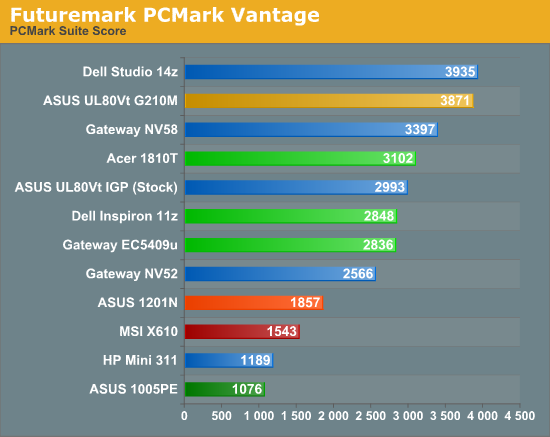
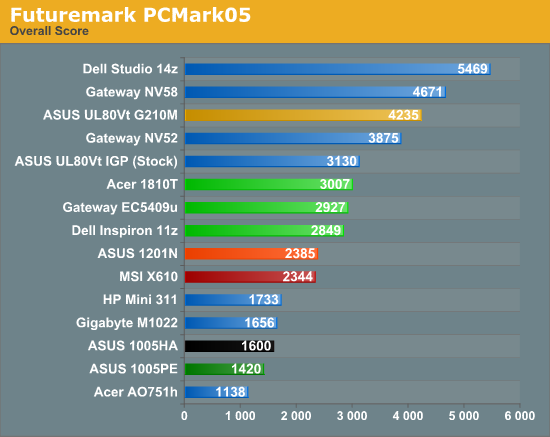
We've shown most of these results in our ASUS 1201N review, but where we were comparing dual-core Atom 330 to Atom N280 and N450, let's now focus on CULV performance. Starting with PCMark, we immediately see a very large performance gap. This isn't some synthetic divide, either: you will very much notice the performance boost moving from Atom N450 to the 1201N, and you'll feel it even more if you compare CULV to Atom N450. Even the Atom 330 is still a big drop in PCMark Vantage, where it's 35% slower than the EC5409u. PCMark05 shows a smaller difference of around 17%, but PCMark05 is relatively outdated now (as the 2005 year indicates).
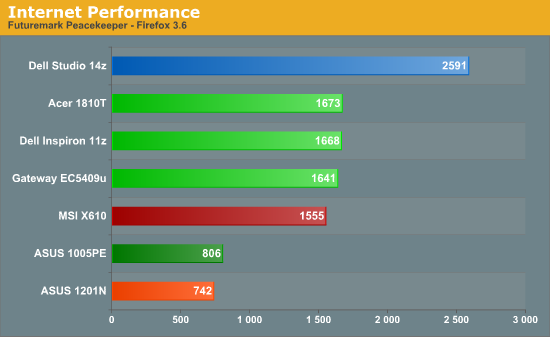
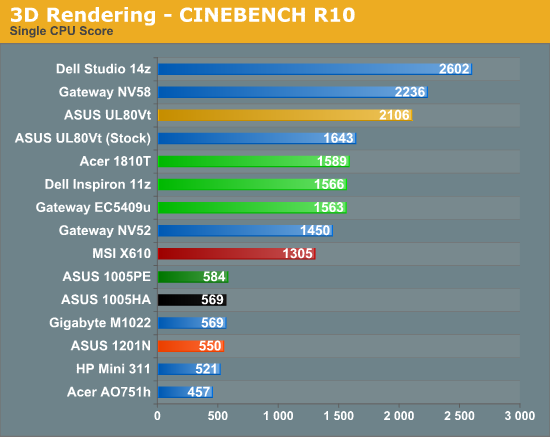
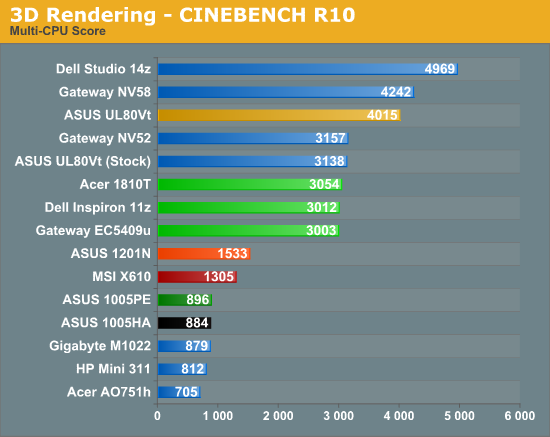
Next up we have Internet Surfing performance measured by the Futuremark Peacekeeper benchmark using Firefox 3.6. Peacekeeper is single-threaded in nature, taxing only one CPU core, but this is quite realistic for many non-video websites. Here the Atom 330 is hurt by its lower clock speed relative to N280/N450, and the jump to CULV roughly doubles performance. If you tend to surf simple text/image sites, the gulf may not be quite so large, but on most modern websites there's a clear difference between rendering times on Atom compared to CULV.
Similarly, CINEBENCH allows us to show quite clearly the difference between single-threaded and multi-threaded tasks. In single CPU mode, the CULV laptops are about 2.5 times as fast as Atom - N280, N450, or 330 doesn't matter. In tasks that can use multiple threads efficiently, the gap between CULV and Atom 330 closes a bit. CULV is still nearly twice as fast as the 330, but it's also 3.35 times as fast as N450. Remember that the multi-threading on N450 is actually Hyper-Threading (SMT) rather than two complete CPU cores, so this is expected.
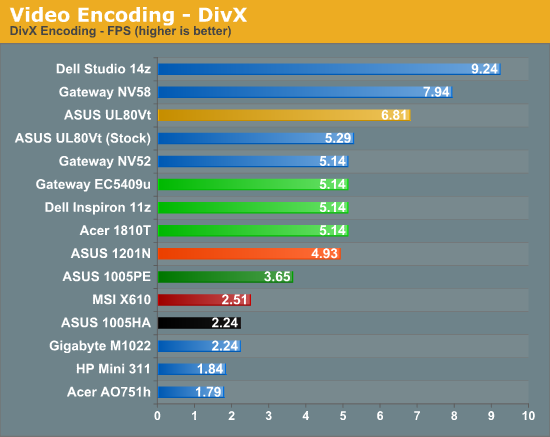
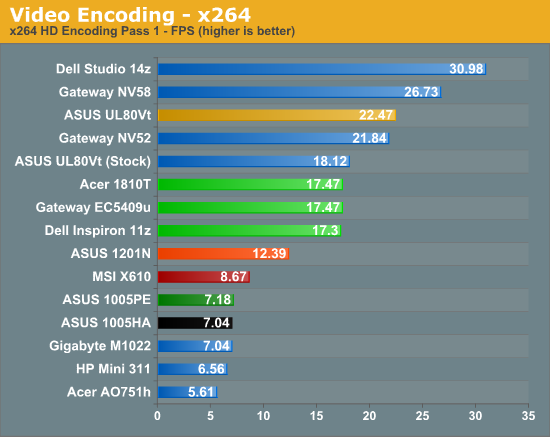
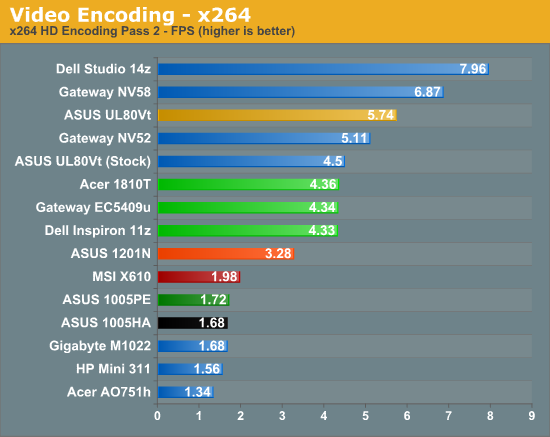
Wrapping things up with some heavily threaded video encoding tests, the four threads on 330 can at times come close to a 1.3GHz CULV. The best result is in DivX encoding where the 330 is only 4% slower than the various CULV laptops. x264 is more strenuous and the CULV offerings are 30~40% faster than Atom 330. Meanwhile, the "new and improved" Atom N450 shows only a very small improvement relative to N280, with CULV still delivering about 2.5 times the performance.
So as you would expect, the performance comparison between Atom and CULV is a lopsided affair. Atom is about keeping costs and power requirements low, and performance just isn't a major concern. Yes, it can run Windows 7, but you wouldn't want an Atom-based system to be your primary computer if at all possible. Given the pricing, you also wouldn't want to spend much over $300 unless you really like some of the other features on an Atom netbook (e.g. perhaps the chassis and build quality are a lot better than the competition). For the most part, Atom wins the price wars, but what about power and battery life?










62 Comments
View All Comments
JarredWalton - Friday, February 5, 2010 - link
There's not a ton of flex - nowhere near as bad as some older MSI laptops, for example - but it does have a bit of spring and it's a "soft touch" keyboard, which just feels mushy to me. I prefer a bit more click, and the spacing and shape of the keys on the 1810 wasn't as nice as the 11z. But, that's a lot of personal preference so if you like the 1810 keyboard there's nothing else I'd complain about with the design.OCedHrt - Thursday, February 4, 2010 - link
Maybe it is just me, but the graphs would be a lot clear if the processors were listed out.I assume the power draw graphs at the end of the battery page is based on the run time and battery capacity?
JarredWalton - Thursday, February 4, 2010 - link
Power graphs are based on power draw from the outlet, at 100nits LCD brightness, with all power saving features enabled (balanced power profile).Adding the CPU to each line compresses the graphs in a way I don't like. Just to quickly list the various CPUs:
Acer AO751h = Atom Z520
Acer AS1810T = Core 2 Duo SU7300
ASUS 1201N = Atom 330
ASUS 1005HA = Atom N280
ASUS UL80Vt = SU7300 (dark gold = OCed to 1.73GHz)
Dell Inspiron 11z = Pentium SU4100
Dell Studio 14z = P8600
Gateway EC5409u = Pentium SU4100
Gateway NV58 = Pentium T4300
Gateway NV52 = Athlon X2 QL-64
Gigabyte M1022 = Atom N280
HP Mini 311 = ION with Atom N280
MSI X610 = Athlon MV-40
Ralos - Friday, February 5, 2010 - link
The title of the article suggest this is a CULV vs Atom showdown. When I look at the graphics, I don't see this, I see a bunch of Acer vs Asus vs HP vs Dell and from what I gather, performance seems to be similar whatever brand the same CPU is sold with, so it really should show the name/speed of the CPUs in there.JarredWalton - Friday, February 5, 2010 - link
Per request, I've updated the chart colors to highlight other important systems. Atom 330 (ASUS 1201N) is orange, MSI X610 (Athlon MV-40 with HD 4330) is red, ASUS 1005PE (Atom N450 Pine Trail) is dark green, and ASUS 1005HA (Atom N280 Diamondville) is black. Hopefully that will help read the charts.OCedHrt - Thursday, February 4, 2010 - link
Well, thanks for trying anyways :)I guess my question is where a Z550 would stack up. Its safe to say it's 50% faster than the Z520, but I don't see that laptop in the performance line up.
I'd wager that it's marginally faster than the ASUS 1005HA with less power draw (but how much less?).
Basically, I'm trying to figure out what is the possibility of a CULV Sony X laptop in the near future ;) It may be unlikely simply due to die size..
JarredWalton - Thursday, February 4, 2010 - link
I think Z550 gets paired up with the GMA 500 chipset, which is good for HD video decode but I'm not sure that it's actually worth using. I know Linux users don't like it because it's a new proprietary GPU with no driver support.My experience (which is limited to the Acer 751h) was that it frequently crashed; what I don't know is if that was the chipset, or just a poor sample laptop from Acer. I also know that I've heard from a few readers saying they have one that crashes all the time as well. Hopefully it's the 751h and not the chipset.
As far as power draw, it should be about the same as the other Atom laptops - probably more than the 751h and 1005HA, given the 2.0GHz clock. Even then, look at the two N280 units (ASUS 1005HA and Gigabyte M1022) and you can see that not all netbooks are created equal. The Gigabyte seems to be a poor example of a netbook, though, with much worse battery life than the competition.
At 2.0GHz Atom Z550 will still be much slower than any CULV, so I'd recommend sticking with CULV unless the pricing is very compelling.
OCedHrt - Thursday, February 4, 2010 - link
The Z550 actually has a slightly lower (0.1) TDP than the N280. It's not the pricing that's compelling, but the form factor: 1.6 lb 11.1" 10.95"(W) x 0.55"(H) x 7.29"(D)KaarlisK - Friday, February 5, 2010 - link
Power consumption should be lower - the TDP of the entire Poulsbo chipset is only 2.3W. However... the damn GMA 500 is HORRIBLY slow. Even for Aero. And Intel still hasn't (and probably won't) released WDDM1.1/DX10 drivers, even though the hardware supports it. Also, the driver doesn't support 8bpp color at all.OCedHrt - Friday, February 5, 2010 - link
Best bet is probably to not run windows on this one ^^I really wish there was a CULV option, even a core solo would be much better.
I saw in some forum that they got OS X running on it. *shudder*